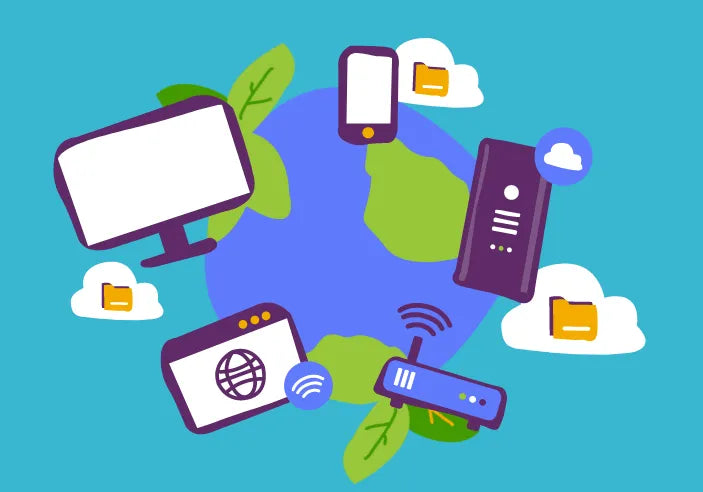What Is Your Digital Carbon Footprint?
Your digital carbon footprint is the amount of greenhouse gas (GHG) emissions from digital technology such as internet usage, data storage, data centres and software applications. It also includes the emissions associated with manufacturing, using, and disposing of the digital devices themselves. There are a number of actions people can take to reduce their footprint from smaller ones, like having a cloud storage clear up, to bigger ones including extending device life and making sure you recycle old phones and laptops. We’ll cover each in turn.
Steps To Clean Up Your Cloud Storage
If you store photos on your phone, they are often actually held in ‘the cloud’. Cloud data is stored in data centres, which use services that are powered by electricity and need water for cooling. The average iPhone user has 50 GB of storage in the cloud and it’s growing all the time. That’s more than 10,000 photos! So, the less photos, videos, emails or files we all store in the cloud, the less energy and resources will be used. Why not start with our Giki step to have a cloud clear-up and only use the storage that you need in the cloud.
Anything stored on your computer also consumes memory and power, hence producing CO2. Storing things you don’t need wastes energy, so removing anything unnecessary will make a small carbon saving.
You can have a clear up of your emails by deleting anything you don’t need anymore, especially junk emails, or those with files attached. As well as cutting back on storage you can reduce energy use by cutting back on the size of any email attachments that you send (and how many people you send them to).
The Benefits Of Reducing Your Cloud Storage
There are several benefits, other than just reducing CO2 emissions, in reducing your computer, email and cloud storage. For example:
- Prolongs your devices’ lifespan as you don’t run out of storage
- Speeds up and simplifies information sharing and finding
- Reduces data storage security risks
- Less storage used in the cloud means less cost
How To Minimise The Impact Of Our Devices
The production of electronic devices consumes a lot of energy and requires precious and rare metals which need to be mined. A new smart phone can have a carbon footprint of over 75kg but a laptop or desktop could be 4 times that amount. The biggest part of this comes from the manufacture of the product. This is often the largest part of someone’s digital carbon footprint.
There are lots of ways to reduce the number of new devices we buy, as well as making sure we are reducing the e-waste from old devices.
Making our devices last longer
This isn’t just about taking care of your electrical equipment, it’s more about holding off on that new purchase, or upgrade, unless you really need to.
The urge to upgrade to the latest gadget is surprisingly strong, so before you buy, try our ‘new device checklist’. Completing the checklist can help you save money either by avoiding, repairing, or buying second hand. It’ll also avoid the hassle of shifting onto a new device too.
Repairing rather than replacing
When a device, like a laptop or phone, starts to have problems, 6 out of 10 people look for a replacement, rather than thinking about repair. However, having your device repaired can save money, cut back on e-waste and cut the carbon emissions and energy needed to make a new phone.
Buying refurbished instead of new
A refurbished device is a used phone, laptop or tablet that has been restored to a good working condition by the original manufacturer or a third-party seller. It might have some signs of wear and tear, but if you buy a refurbished device, you’ll save money plus the carbon emissions and resources that are needed to make a new device. Many of the big manufacturers including Apple, Samsung, Dell and HP now offer refurbished devices.
What To Do With Old Devices
Electronic waste (e-waste) is one of the fastest growing types of waste in the world. But many of the electrical items that are thrown away can be repaired, re-used or recycled. Anything with a plug, cable or battery can usually be recycled. It is easier to do than you might think, as lots of shops have collection points.
Recycling your old devices helps to save materials and resources, for example, old cell phones contain valuable materials such as copper, rare earth metals and even gold! Recycling them allows them to be reused and means the materials don’t need to be dug out of the ground again which can be very destructive.
Recycling also avoids landfill where electrical items “leak” causing soil and water contamination and reduces the associated environmental and health risks.

